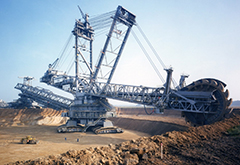Bucket Wheel Excavator
Bucket-wheel excavators (BWEs) are heavy equipment used in surface mining. The primary function of BWEs is to act as a continuous digging machine in large-scale open-pit mining operations. What sets BWEs apart from other large-scale mining equipment, such as bucket chain excavators, is their use of a large wheel consisting of a continuous pattern of buckets used to scoop material as the wheel turns. They are among the largest vehicles ever constructed, and the biggest bucket-wheel excavator ever built, Bagger 293, is the largest terrestrial (land) vehicle in history by weight (14,200 tonnes), according to the Guinness Book of World Records.
 Bucket-wheel excavators have been used in mining for the past century, with some of the first being manufactured in the 1920s. They are used in conjunction with many other pieces of mining machinery (conveyor belts, spreaders, crushing stations, heap-leach systems, etc.) to move and mine massive amounts of overburden (waste). While the overall concepts that go into a BWE have not changed much, their size has grown drastically since the end of World War II.
Bucket-wheel excavators have been used in mining for the past century, with some of the first being manufactured in the 1920s. They are used in conjunction with many other pieces of mining machinery (conveyor belts, spreaders, crushing stations, heap-leach systems, etc.) to move and mine massive amounts of overburden (waste). While the overall concepts that go into a BWE have not changed much, their size has grown drastically since the end of World War II.In the 1950s two German mining firms ordered the world's first extremely large BWEs, and had three BWEs built for mining lignite near Cologne, Germany. The German BWEs had a wheel of over 52 feet (16 m) in diameter, weighed 5,500 short tons (5,000 t) and was over 600 feet (180 m) long, with eighteen crawler units for movement and could cut a swath of over 600 feet (180 m) at one time
Bucket-wheel excavators built since the 1990s, such as the Bagger 293, have reached sizes as large as 96 metres (315 ft) tall, 225 metres (738 ft) long, and as heavy as 14,200 tonnes (31,300,000 lb). The bucket-wheel itself can be over 70 feet (21 m) in diameter with as many as 20 buckets, each of which can hold over 15 cubic metres of material. BWEs have also advanced with respect to the extreme conditions in which they are now capable of operating. Many BWEs have been designed to operate in climates with temperatures as low as −45 °C (−49 °F). Developers are now moving their focus toward automation and the use of electrical power. More details
